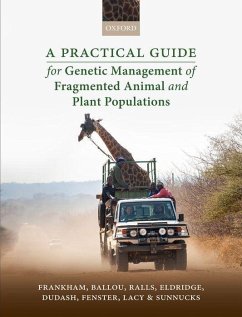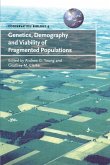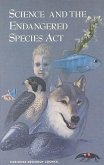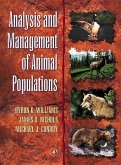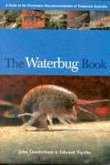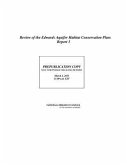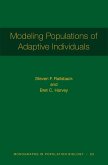Richard Frankham, Jonathan D Ballou, Katherine Ralls, Mark Eldridge, Michele R Dudash, Charles B Fenster, Robert C Lacy, Paul Sunnucks
A Practical Guide for Genetic Management of Fragmented Animal and Plant Populations
Richard Frankham, Jonathan D Ballou, Katherine Ralls, Mark Eldridge, Michele R Dudash, Charles B Fenster, Robert C Lacy, Paul Sunnucks
A Practical Guide for Genetic Management of Fragmented Animal and Plant Populations
- Broschiertes Buch
- Merkliste
- Auf die Merkliste
- Bewerten Bewerten
- Teilen
- Produkt teilen
- Produkterinnerung
- Produkterinnerung
This book provides an authoritative and timely practical guide to genetic management of fragmented populations, with critically important practical implications in conservation biology. It seeks to enable a paradigm shift in the genetic management of small isolated population fragments by encouraging genetic rescues.
Andere Kunden interessierten sich auch für
![Genetics, Demography and Viability of Fragmented Populations Genetics, Demography and Viability of Fragmented Populations]() G. Young / M. Clarke (eds.)Genetics, Demography and Viability of Fragmented Populations88,99 €
G. Young / M. Clarke (eds.)Genetics, Demography and Viability of Fragmented Populations88,99 €![Science and the Endangered Species ACT Science and the Endangered Species ACT]() National Research CouncilScience and the Endangered Species ACT64,99 €
National Research CouncilScience and the Endangered Species ACT64,99 €![Analysis and Management of Animal Populations Analysis and Management of Animal Populations]() Byron K WilliamsAnalysis and Management of Animal Populations217,99 €
Byron K WilliamsAnalysis and Management of Animal Populations217,99 €![Waterbug Book Waterbug Book]() Edward TsyrlinWaterbug Book54,99 €
Edward TsyrlinWaterbug Book54,99 €![Just Bats Just Bats]() M Brock FentonJust Bats39,99 €
M Brock FentonJust Bats39,99 €![Review of the Edwards Aquifer Habitat Conservation Plan Review of the Edwards Aquifer Habitat Conservation Plan]() National Research CouncilReview of the Edwards Aquifer Habitat Conservation Plan62,99 €
National Research CouncilReview of the Edwards Aquifer Habitat Conservation Plan62,99 €![Modeling Populations of Adaptive Individuals Modeling Populations of Adaptive Individuals]() Steven F RailsbackModeling Populations of Adaptive Individuals55,99 €
Steven F RailsbackModeling Populations of Adaptive Individuals55,99 €-
-
-
This book provides an authoritative and timely practical guide to genetic management of fragmented populations, with critically important practical implications in conservation biology. It seeks to enable a paradigm shift in the genetic management of small isolated population fragments by encouraging genetic rescues.
Hinweis: Dieser Artikel kann nur an eine deutsche Lieferadresse ausgeliefert werden.
Hinweis: Dieser Artikel kann nur an eine deutsche Lieferadresse ausgeliefert werden.
Produktdetails
- Produktdetails
- Verlag: Oxford University Press
- Seitenzahl: 198
- Erscheinungstermin: 23. Dezember 2019
- Englisch
- Abmessung: 244mm x 188mm x 13mm
- Gewicht: 431g
- ISBN-13: 9780198783428
- ISBN-10: 0198783426
- Artikelnr.: 57010177
- Herstellerkennzeichnung
- Libri GmbH
- Europaallee 1
- 36244 Bad Hersfeld
- 06621 890
- Verlag: Oxford University Press
- Seitenzahl: 198
- Erscheinungstermin: 23. Dezember 2019
- Englisch
- Abmessung: 244mm x 188mm x 13mm
- Gewicht: 431g
- ISBN-13: 9780198783428
- ISBN-10: 0198783426
- Artikelnr.: 57010177
- Herstellerkennzeichnung
- Libri GmbH
- Europaallee 1
- 36244 Bad Hersfeld
- 06621 890
Emeritus Professor Richard Frankham is one of the leading international figures in conservation genetics, having been a pioneering researcher in the discipline and senior author on the first textbooks in the field. In 2005 he was awarded a DSc by Macquarie University (in Sydney, Australia), based upon his published work (now > 170 publications). Throughout his career he has worked on the genetic impacts of small population sizes in the contexts of conservation and evolutionary genetics and animal breeding. In 2017 he was awarded the MJD White Medal of the Genetics Society of AustralAsia for his career contributions to conservation and evolutionary genetics. His background is in agriculture (BScAgr [Hons 1] and PhD from the University of Sydney, Australia). He worked for Agriculture Canada (1967-69), followed by a postdoctoral fellowship at the University of Chicago (1969-71), before spending 31 years at Macquarie University. He officially retired in 2002, but continues to work full-time. Jonathan Ballou is a Research Scientist Emeritus at the Smithsonian Institution's Smithsonian Conservation Biology Institute in Washington, DC and from 2003-2006 was Head of its Department of Conservation Biology. His research has focused on the genetic and demographic problems confronted by small populations, especially of threatened species. He is recognized as a leader in developing the theoretical basis for the genetic management of small populations and in developing population management tools (software, applied theory) that are widely and internationally used by wildlife and zoo managers. Jon received his bachelor's degree in Animal Behavior from the University of Virginia in 1977, his masters in statistics at George Washington University in 1985 and his PhD in Population Genetics from the University of Maryland in 1995. Katherine Ralls is interested in the behavioural ecology and conservation of mammals. She studied biology at Stanford and received her PhD from Harvard. An Emerita Research Zoologist with the Smithsonian's Conservation Biology Institute, she worked at the Smithsonian's National Zoo from 1976 until her retirement in 2014. Her work with co-author Jonathon Ballou on inbreeding problems in captive mammals led to her interest in conservation. In addition to her work on the genetics of small populations, she helped found the Society for Conservation Biology, studies endangered foxes and sea otters, and has served on recovery teams for several endangered species. Mark Eldridge studied genetics and zoology for a BSc (Hons) at Macquarie University and then received a PhD from Macquarie University in 1992. He was awarded an Australian Postdoctoral Research Fellowship in 1992 and a QEII Fellowship in 1999. He was appointed as a Research Scientist at the Australian Museum in 2007 and has continued to use molecular techniques to study marsupial evolution, taxonomy and conservation biology. He has worked on over 150 scientific publications. Michele Dudash is a population biologist by training, hence her research focuses on both the ecological and genetic factors responsible for a population's persistence or demise in nature. In this context the major theme of her research has been the ecology and evolution of reproductive systems in nature. Together with colleagues and students she has investigated plant mating system evolution, plant-pollinator interactions, demography of populations, and the role inbreeding, inbreeding depression, and phenotypic plasticity play in the evolution of plant populations. Her research program is directly related with the need for baseline data that may be utilized to help form successful conservation and restoration management plans for threatened taxa. In addition to her previous academic appointments she has served at the National Science Foundation and is currently in an administrative Head post. Charles Fenster developed an interest in population dynamics and genetics that was piqued by observations in Flushing Meadows, and fostered by mentors at Stuyvesant High School and the Jackson Laboratory (notably Robert Collins). While at Amherst College he was inspired to redirect his interests in genetics to evolution by Douglas Schemske who later became his PhD mentor at the University of Chicago. Douglas Schemske and later postdoc mentors at the University of Toronto, Spencer Barrett and Kermit Ritland, encouraged genetic studies in a natural context as an effective way to understand the genetics underlying evolutionary process. These research goals also led to an interest in the conservation of biodiversity. His current work focuses on the origin of genetic diversity through the study of mutations, investigating the relationship between angiosperm structure and function as a model for natural selection and how sustainable farming practices may contribute to the maintenance of biodiversity. Robert C. Lacy recently retired after a 34-year career as a Senior Conservation Scientist for the Chicago Zoological Society. He serves on the faculty of the Committee on Evolutionary Biology at University of Chicago, and he is Science Advisor to the IUCN Conservation Planning Specialist Group. He has served as Chair of the IUCN Conservation Breeding Specialist Group (2003-2011), and he was Chair of an IUCN Species Conservation Planning Task Force that developed a framework for strategic planning for species conservation. Together with co-author Jonathan Ballou, he helped to develop the pedigree analysis methods used for the management of captive populations in zoos. Similarly, his population viability analysis software (Vortex) is used by conservationists, wildlife managers, researchers, and students throughout the world to help guide species risk assessments and conservation planning. Paul Sunnucks studied Zoology at Oxford University, and then completed a PhD in population biology at University College London. During three years in one the world's first conservation genetics groups at the Institute of Zoology London, Paul married Australian Andrea Taylor and subsequently migrated to Australia. Following research positions in Sydney, and embarking on parenting, he moved to Melbourne. Since 2005 at Monash University, he has headed the Persistence and Adaptation Research Team. Paul's research applies ecological genomics to conservation-relevant population biology. He has a particular liking for all lifeforms, and working with smart, fun people.
* 1: Introduction
* Section I
* Genetic problems in small isolated populations and their remedies
* 2: Evolutionary genetics of small populations
* 3: Inbreeding and loss of genetic diversity increase extinction risk
* 4: Population fragmentation causes inadequate gene flow and increases
extinction risk
* 5: Genetic rescue resulting from gene flow
* Section II
* Making genetic management decisions
* 6: Appropriate delineation of species for conservation purposes
* 7: Are there populations suffering genetic erosion that would benefit
from gene flow?
* 8: Managing gene flow among isolated population fragments
* 9: Global climate change increases the need for genetic management
* Section I
* Genetic problems in small isolated populations and their remedies
* 2: Evolutionary genetics of small populations
* 3: Inbreeding and loss of genetic diversity increase extinction risk
* 4: Population fragmentation causes inadequate gene flow and increases
extinction risk
* 5: Genetic rescue resulting from gene flow
* Section II
* Making genetic management decisions
* 6: Appropriate delineation of species for conservation purposes
* 7: Are there populations suffering genetic erosion that would benefit
from gene flow?
* 8: Managing gene flow among isolated population fragments
* 9: Global climate change increases the need for genetic management
* 1: Introduction
* Section I
* Genetic problems in small isolated populations and their remedies
* 2: Evolutionary genetics of small populations
* 3: Inbreeding and loss of genetic diversity increase extinction risk
* 4: Population fragmentation causes inadequate gene flow and increases
extinction risk
* 5: Genetic rescue resulting from gene flow
* Section II
* Making genetic management decisions
* 6: Appropriate delineation of species for conservation purposes
* 7: Are there populations suffering genetic erosion that would benefit
from gene flow?
* 8: Managing gene flow among isolated population fragments
* 9: Global climate change increases the need for genetic management
* Section I
* Genetic problems in small isolated populations and their remedies
* 2: Evolutionary genetics of small populations
* 3: Inbreeding and loss of genetic diversity increase extinction risk
* 4: Population fragmentation causes inadequate gene flow and increases
extinction risk
* 5: Genetic rescue resulting from gene flow
* Section II
* Making genetic management decisions
* 6: Appropriate delineation of species for conservation purposes
* 7: Are there populations suffering genetic erosion that would benefit
from gene flow?
* 8: Managing gene flow among isolated population fragments
* 9: Global climate change increases the need for genetic management

